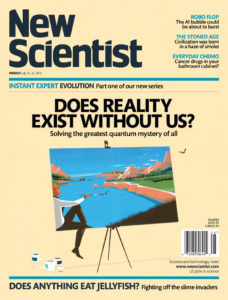Our best theory of reality says things only become real when we look at them. Understanding how the universe came to be requires a better explanation
 WHERE, when you aren’t looking at it, is a subatomic particle? A quantum physicist would probably answer: sort of all over the place. An unobserved particle is a wisp of reality, a shimmer of existence – there isn’t a good metaphor for it, because it is vague both by definition and by nature. Until you do have a peek. Then it becomes a particle proper, it can be put into words, it is a thing with a place.
WHERE, when you aren’t looking at it, is a subatomic particle? A quantum physicist would probably answer: sort of all over the place. An unobserved particle is a wisp of reality, a shimmer of existence – there isn’t a good metaphor for it, because it is vague both by definition and by nature. Until you do have a peek. Then it becomes a particle proper, it can be put into words, it is a thing with a place.
That picture seems utterly absurd. Yet many, many experiments exploring the microscopic realm over the best part of a century have reinforced the conclusion that when we’re not paying attention, the world is fuzzy and undecided. Only by looking at things, observing them, measuring them, do we make them recognisably “real”.
Einstein was unimpressed, pointedly asking whether the moon is not there if no one is looking at it. But then Einstein was always raising pesky objections to quantum theory. For many physicists since it has been a case of swallowing any philosophical qualms. The maths works, there’s no real alternative, so get on with it. Shut up and calculate.
Except that, just maybe, there is now an alternative. A new twist on standard quantum theory promises not only to rid reality of its observer problem, but also to answer a host of unresolved issues in cosmology, from the workings of black holes to the nature of dark energy to why time flows in only one direction. “It has the potential of providing a very plausible way out of the problems at stake,” says quantum physicist Angelo Bassi at the University of Trieste in Italy. Is it for real? […]
The rest of this article is available here.
 WHERE, when you aren’t looking at it, is a subatomic particle? A quantum physicist would probably answer: sort of all over the place. An unobserved particle is a wisp of reality, a shimmer of existence – there isn’t a good metaphor for it, because it is vague both by definition and by nature. Until you do have a peek. Then it becomes a particle proper, it can be put into words, it is a thing with a place.
WHERE, when you aren’t looking at it, is a subatomic particle? A quantum physicist would probably answer: sort of all over the place. An unobserved particle is a wisp of reality, a shimmer of existence – there isn’t a good metaphor for it, because it is vague both by definition and by nature. Until you do have a peek. Then it becomes a particle proper, it can be put into words, it is a thing with a place.